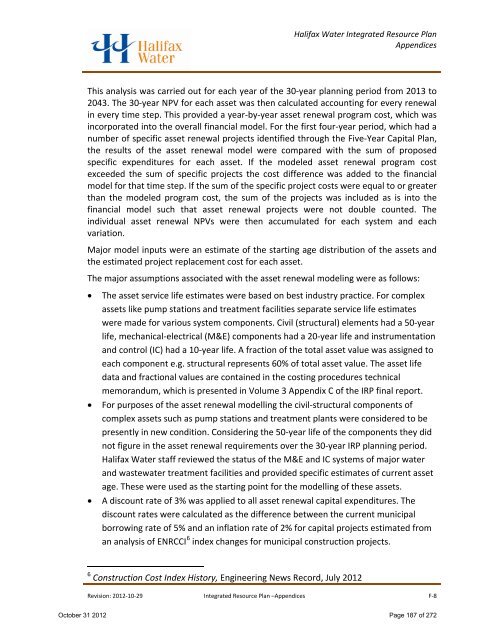volume 1 - Halifax Regional Municipality
volume 1 - Halifax Regional Municipality
volume 1 - Halifax Regional Municipality
Create successful ePaper yourself
Turn your PDF publications into a flip-book with our unique Google optimized e-Paper software.
<strong>Halifax</strong> Water Integrated Resource Plan<br />
Appendices<br />
This analysis was carried out for each year of the 30-year planning period from 2013 to<br />
2043. The 30-year NPV for each asset was then calculated accounting for every renewal<br />
in every time step. This provided a year-by-year asset renewal program cost, which was<br />
incorporated into the overall financial model. For the first four-year period, which had a<br />
number of specific asset renewal projects identified through the Five-Year Capital Plan,<br />
the results of the asset renewal model were compared with the sum of proposed<br />
specific expenditures for each asset. If the modeled asset renewal program cost<br />
exceeded the sum of specific projects the cost difference was added to the financial<br />
model for that time step. If the sum of the specific project costs were equal to or greater<br />
than the modeled program cost, the sum of the projects was included as is into the<br />
financial model such that asset renewal projects were not double counted. The<br />
individual asset renewal NPVs were then accumulated for each system and each<br />
variation.<br />
Major model inputs were an estimate of the starting age distribution of the assets and<br />
the estimated project replacement cost for each asset.<br />
The major assumptions associated with the asset renewal modeling were as follows:<br />
• The asset service life estimates were based on best industry practice. For complex<br />
assets like pump stations and treatment facilities separate service life estimates<br />
were made for various system components. Civil (structural) elements had a 50-year<br />
life, mechanical-electrical (M&E) components had a 20-year life and instrumentation<br />
and control (IC) had a 10-year life. A fraction of the total asset value was assigned to<br />
each component e.g. structural represents 60% of total asset value. The asset life<br />
data and fractional values are contained in the costing procedures technical<br />
memorandum, which is presented in Volume 3 Appendix C of the IRP final report.<br />
• For purposes of the asset renewal modelling the civil-structural components of<br />
complex assets such as pump stations and treatment plants were considered to be<br />
presently in new condition. Considering the 50-year life of the components they did<br />
not figure in the asset renewal requirements over the 30-year IRP planning period.<br />
<strong>Halifax</strong> Water staff reviewed the status of the M&E and IC systems of major water<br />
and wastewater treatment facilities and provided specific estimates of current asset<br />
age. These were used as the starting point for the modelling of these assets.<br />
• A discount rate of 3% was applied to all asset renewal capital expenditures. The<br />
discount rates were calculated as the difference between the current municipal<br />
borrowing rate of 5% and an inflation rate of 2% for capital projects estimated from<br />
an analysis of ENRCCI 6 index changes for municipal construction projects.<br />
6 Construction Cost Index History, Engineering News Record, July 2012<br />
Revision: 2012-10-29 Integrated Resource Plan –Appendices F-8<br />
October 31 2012 Page 187 of 272
















